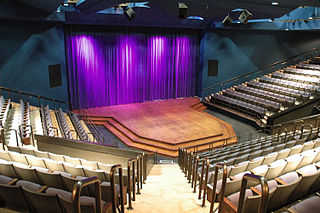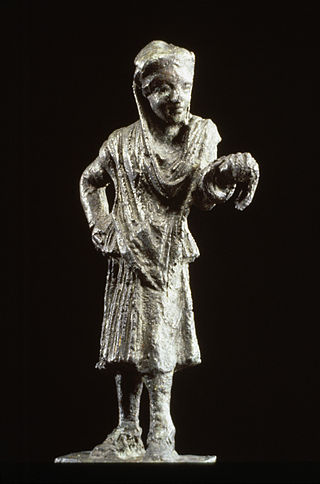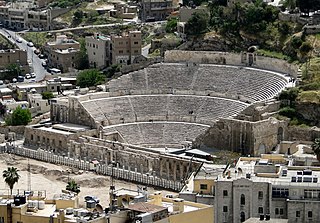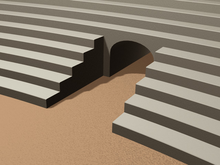
The Colosseum is an elliptical amphitheatre in the centre of the city of Rome, Italy, just east of the Roman Forum. It is the largest ancient amphitheatre ever built, and is still the largest standing amphitheatre in the world, despite its age. Construction began under the Emperor Vespasian in 72 and was completed in AD 80 under his successor and heir, Titus. Further modifications were made during the reign of Domitian. The three emperors who were patrons of the work are known as the Flavian dynasty, and the amphitheatre was named the Flavian Amphitheatre by later classicists and archaeologists for its association with their family name (Flavius).

An amphitheatre is an open-air venue used for entertainment, performances, and sports. The term derives from the ancient Greek ἀμφιθέατρον, from ἀμφί, meaning "on both sides" or "around" and θέατρον, meaning "place for viewing".

A proscenium is the metaphorical vertical plane of space in a theatre, usually surrounded on the top and sides by a physical proscenium arch and on the bottom by the stage floor itself, which serves as the frame into which the audience observes from a more or less unified angle the events taking place upon the stage during a theatrical performance. The concept of the fourth wall of the theatre stage space that faces the audience is essentially the same.

The Stratford Festival is a theatre festival which runs from April to October in the city of Stratford, Ontario, Canada. Founded by local journalist Tom Patterson in 1952, the festival was formerly known as the Stratford Shakespearean Festival, the Shakespeare Festival and the Stratford Shakespeare Festival. The festival was one of the first arts festivals in Canada and continues to be one of its most prominent. It is recognized worldwide for its productions of Shakespearean plays.

The Royal Shakespeare Theatre (RST) is a Grade II* listed 1,040+ seat thrust stage theatre owned by the Royal Shakespeare Company dedicated to the English playwright and poet William Shakespeare. It is located in the town of Stratford-upon-Avon – Shakespeare's birthplace – in the English Midlands, beside the River Avon. The building incorporates the smaller Swan Theatre. The Royal Shakespeare and Swan Theatres re-opened in November 2010 after undergoing a major renovation known as the Transformation Project.

In theatre, a thrust stage is one that extends into the audience on three sides and is connected to the backstage area by its upstage end. A thrust has the benefit of greater intimacy between performers and the audience than a proscenium, while retaining the utility of a backstage area. This is in contrast to a theatre in the round, which is exposed on all sides to the audience, is without a backstage, and relies entirely on entrances in the auditorium or from under the stage. Entrances onto a thrust are most readily made from backstage, although some theatres provide for performers to enter through the audience using vomitory entrances. As with an arena, the audience in a thrust stage theatre may view the stage from three or more sides. Because the audience can view the performance from a variety of perspectives, it is usual for the blocking, props and scenery to receive thorough consideration to ensure that no perspective is blocked from view. A high-backed chair, for instance, when placed stage right, could create a blind spot in the stage left action.

A theatrical culture flourished in ancient Greece from 700 BC. At its centre was the city-state of Athens, which became a significant cultural, political, and religious place during this period, and the theatre was institutionalised there as part of a festival called the Dionysia, which honoured the god Dionysus. Tragedy, comedy, and the satyr play were the three dramatic genres emerged there. Athens exported the festival to its numerous colonies. Modern Western theatre comes, in large measure, from the theatre of ancient Greece, from which it borrows technical terminology, classification into genres, and many of its themes, stock characters, and plot elements.

Roman theatres derive from and are part of the overall evolution of earlier Greek theatres. Much of the architectural influence on the Romans came from the Greeks, and theatre structural design was no different from other buildings. However, Roman theatres have specific differences, such as generally being built upon their own foundations instead of earthen works or a hillside and being completely enclosed on all sides.

In theatre and performing arts, the stage is a designated space for the performance of productions. The stage serves as a space for actors or performers and a focal point for the audience. As an architectural feature, the stage may consist of a platform or series of platforms. In some cases, these may be temporary or adjustable but in theaters and other buildings devoted to such productions, the stage is often a permanent feature.

The Theatre of Pompey, also known by other names, was a structure in Ancient Rome built during the latter part of the Roman Republican era by Pompey the Great. Completed in 55 BC, it was the first permanent theatre to be built in Rome. Its ruins are located at Largo di Torre Argentina.

A theater, or playhouse, is a structure where theatrical works, performing arts, and musical concerts are presented. The theater building serves to define the performance and audience spaces. The facility usually is organized to provide support areas for performers, the technical crew and the audience members, as well as the stage where the performance takes place.

In live entertainment there are several possible schemes for the seating assignment of spectators, including completely unassigned seating. There are several schemes most commonly used, though there are no firm rules, and alternate or modified schemes are sometimes used.

The Cemil Topuzlu Open-Air Theatre is a contemporary amphitheatre located at Harbiye neighborhood of Şişli district in Istanbul, Turkey. It is situated across from the Istanbul Lütfi Kırdar Convention and Exhibition Center, and behind the Hilton Istanbul Bosphorus on the European side of the city.
There are different types of theatres, but they all have three major parts in common. Theatres are divided into two main sections, the house and the stage; there is also a backstage area in many theatres. The house is the seating area for guests watching a performance and the stage is where the actual performance is given. The backstage area is usually restricted to people who are producing or in the performance.

Roman amphitheatres are theatres — large, circular or oval open-air venues with tiered seating — built by the ancient Romans. They were used for events such as gladiator combats, venationes and executions. About 230 Roman amphitheatres have been found across the area of the Roman Empire. Early amphitheatres date from the Republican period, though they became more monumental during the Imperial era.

The Roman Theatre of Mérida is a Roman theatre in the Roman colonia of Emerita Augusta –present-day Mérida, Spain–, capital of the Roman province of Lusitania. Its construction was promoted by the consul Vipsanius Agrippa and was built in 16–15 BCE. It was used for Roman theatrical performances during ancient Rome. Since 1933, it houses the International Festival of Classical Theatre of Mérida.

The Allen Elizabethan Theatre has evolved since the founding of the Oregon Shakespeare Festival when the first performance of Twelfth Night was presented on July 2, 1935.

The Holborn Theatre was a theatre on High Holborn in London which opened in 1867 as the New Royal Amphitheatre and operated as an equestrian ring and theatre until 1886. During its short existence the theatre underwent numerous name changes, becoming the Holborn Theatre in 1884.

The Roman Theatre in Bregenz, Vorarlberg, Austria, is located in the quarter of Thalbach in Bregenz. Bregenz was called Brigantium by the Romans. The theatre was excavated by archaeologists specifically in 2013 and 2019 in the name of the Vorarlberg provincial museum.

The Roman amphitheatre of Albano Laziale is a Roman amphitheatre located in Albano Laziale, Lazio.




















